Episodes
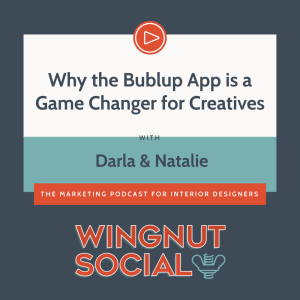
Monday Oct 21, 2019
Monday Oct 21, 2019
Bublup advertises itself as “the cloud reimagined”. Why are Darla and Natalie so fascinated by it? It’s changing the way the world looks at storage. It allows you to save everything in visual folders—PDFs, photos, videos, GIFs, notes, and more.
It’s akin to Pinterest, Dropbox, and Google Drive on steroids. So how can an interior designer use the application? Are the unique applications of it worth the learning curve? Darla and Natalie chat all about it in this episode of Wingnut Social.
What You’ll Hear On This Episode of Wingnut Social
[1:50] All about Bublup
[3:40] The Bublup Superpower is “Rolls”
[5:20] All this is for free
[6:30] Send a roll to clients
[7:40] How the app acts as a reverse plugin
Resources & People Mentioned
Bublup.com
Darla’s Bublup Roll
Darla Powell Interiors: Instagram
The digital vision board for creatives
Bublup has an extension that you can utilize on Google Chrome that allows you to clip an article, photos, videos—or anything that you desire and save it to a folder. It’s a digital vision board for any project you may be doing that you can even share directly with clients.
Darla’s even planning on making a folder for Disney World’s Star Wars park. The applications are endless, and honestly it can easily become an obsession. It seems a far better way to organize cloud storage and it’s enjoyable. Win-win.
Bublup’s superpower lies in its Rolls
You can transform your folders into what Bublup terms “Rolls”. It’s similar to the organization of a basic landing page for a website—but it’s anything but basic. Once you’ve completed your Roll, you can easily share it with anyone by sending them a link.
Darla created a Roll that is linked below in the show notes, go check it out!
This could revolutionize the way you can share projects and ideas with friends, family, and even clients. Even better, Bublup is completely free. You can upgrade to paid plans for more storage and upload capacity. Be sure to give the free version a shot and change the way you organize storage.
Connect With Darla & Wingnut Social
www.WingnutSocial.com
On Facebook
On Twitter: @WingnutSocial
On Instagram: @WingnutSocial
Darla’s Interior Design Website
1-877-WINGNUT (connect with us for your social media marketing needs)
Subscribe to The Wingnut Social Podcast on iTunes, Google Podcasts, or TuneIn
Audio Production and Show notes byPODCAST FAST TRACKhttps://www.podcastfasttrack.com

Wednesday Oct 16, 2019
Wednesday Oct 16, 2019
Do you know how to create Pinterest pins that are eye-catching, informational, and worthy of going viral? Or does Pinterest endlessly baffle you? So many assume that it operates like Instagram but that is far from the case. If you’re ready to create pins that pop—that drive traffic to your website—listen to this episode of the Wingnut social podcast with Shana Heinricy.
Shana is currently Wingnut Social’s director and the genius behind our marketing strategy. She holds a master’s degree in communications and has worked in public relations and communications all of her professional life. She loves the creativity social media affords her while also satisfying her analytical side and need to see consistent results.
What You’ll Hear On This Episode of Wingnut Social
[3:00] Shana Heinricy: Director of Wingnut Social
[3:55] Breathtaking Tailwind Statistics
[8:30] What sets Pinterest apart from other platforms?
[10:15] Making the videos and photos searchable
[11:40] How an Interior Designer can benefit from Pinterest
[13:10] What demographic is on Pinterest?
[15:20] Should you create or recycle content?
[17:00] What does well on Pinterest?
[18:00] How often to post?
[19:00] Curating content vs. repinning
[21:00] How to get a pin to go viral
[25:22] Pinterest ads and promoted pins
[31:20] What up Wingnut round
Connect with Shana
Shana’s LinkedIn
www.WingnutSocial.com
On Instagram: @WingnutSocial
Resources & People Mentioned
QR Codes Kill Kittens by Scott Stratten
Tailwind Tribes
Why is Pinterest neglected as a social media platform?
While Instagram is the current obsession and the #1 social media platform you should be using, you need to add Pinterest into your arsenal. Pins (and now videos) that you post on Pinterest are indexed by Google and will show up under a Google image search. This is huge!
Images are the 2nd largest driver of traffic to your website.
So how do you optimize your Pinterest posts to be indexed by Google? It’s all in the details. Your image needs to be titled correctly with your business name and a term that is searchable by Google. Focus on Search Engine Optimization (SEO) and keywords in your caption and remember, unlike Instagram: Everything is searchable on Pinterest.
How to create Pinterest Pins that will go viral
Pinterest is especially valuable for designers who blog or have their own product line. Because—gasp—you can sell directly from Pinterest! Shana says if you fall into those categories, you need to spend a significant amount of time on Pinterest to drive traffic to our products or blogs.
You have to understand that Pinterest is geared toward people experiencing particular life moments. They could be buying and decorating a new house, giving birth to their first child, or planning a wedding. So your keywords need to cater to people immersed in these life moments. Shana says the simplest way to do that is to create pins that will go viral.
But what type of pin tends to succeed above all others? An infographic. Detailed infographics that stand out have the highest likelihood of going viral. Take the blog post that you want to drive traffic to and find a way to visually represent it in an infographic. If your pin is successful, you can take it and boost it—and watch the traffic to your website soar.
Connect With Darla & Wingnut Social
www.WingnutSocial.com
On Facebook
On Twitter: @WingnutSocial
On Instagram: @WingnutSocial
Darla’s Interior Design Website
1-877-WINGNUT (connect with us for your social media marketing needs)
Subscribe to The Wingnut Social Podcast on iTunes, Google Podcasts, or TuneIn
Audio Production and Show notes byPODCAST FAST TRACKhttps://www.podcastfasttrack.com
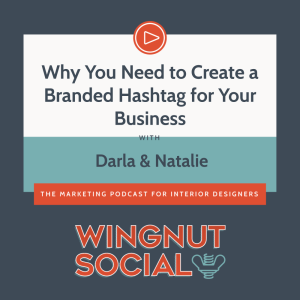
Monday Oct 14, 2019
Monday Oct 14, 2019
Hashtags are all the rage—which is why you NEED to create a branded hashtag for your business. A hashtag is a fun and effective way to build an authentic following. It also allows you to bring your voice to social media.
So are you ready to take your social media presence to the next level? Do you want to build a community for your followers? Listen to this minisode of Wingnut Social with Darla and Natalie to find out how to create a branded hashtag, and why it’s so important.
They share their brand new hashtag in this episode—don’t miss it!
What You’ll Hear On This Episode of Wingnut Social
[0:40] Monday Marketing Mini-sode
[1:00] Branded Hashtags
[2:15] Help separate you from your competitors
[4:20] Creating a branded hashtag 101
[5:55] Designer example
[7:00] We reveal our new branded hashtag
Resources & People Mentioned
LuAnn Nigara - LuAnn Live
LuAnn on Instagram
O’Hara Interiors on Instagram
Build a dedicated community that’s all yours with a branded hashtag
A branded hashtag is one of the best ways to separate you from your competitors. Not only that, but it gives your community a way to connect with you and each other. You can interact and share relevant content that everyone can see by visiting your hashtag.
Find fun ways to draw them into your community.
Ask them to share photos using your special hashtag, like “#WingnutWednesday”. Or post a challenge asking them to do something—like showing off their fall porch decor! The end goal is to give your followers a platform for their content.
Be creative, quirky, and clear!
Your hashtag can’t be boring. For example, “Miami Designer” is just too generic. Martha O’Hara gives us an example of a great branded hashtag: #OHMyStyledLife. It’s fun, it’s catchy, and above all it’s memorable. So give it a shot and see what fun hashtags you can come up with!
You also want to be clear with your followers why they should use your hashtag
You need to offer them value.
So what does that mean? Be clear how you will reward your followers. One of the easiest ways to do that is to share their posts on your social media when they use your branded hashtag. Your follower gets all the credit, and it will help new designers get a reach they wouldn’t have. Who doesn’t want that?!
To hear more—and finally find out what our brand new hashtag is—listen to our minisode now!
Connect With Darla & Wingnut Social
www.WingnutSocial.com
On Facebook
On Twitter: @WingnutSocial
On Instagram: @WingnutSocial
Darla’s Interior Design Website
1-877-WINGNUT (connect with us for your social media marketing needs)
Subscribe to The Wingnut Social Podcast on iTunes, Google Podcasts, or TuneIn
Audio Production and Show notes byPODCAST FAST TRACKhttps://www.podcastfasttrack.com
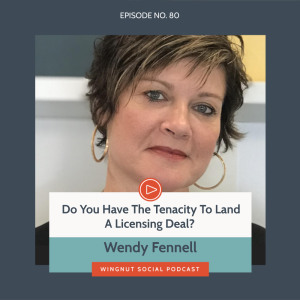
Wednesday Oct 09, 2019
Wednesday Oct 09, 2019
If you’re interested in learning about what it takes to land a licensing deal—this is the episode for you! It can be a difficult process where it often seems impossible to get a licensing deal in place. However, there are some tricks of the trade that can increase your chances of getting the deal done.
On this episode of Wingnut Social, Darla and Natalie chat with Wendy Fennell of Bohemian Bungalow Design. Landing a licensing deal requires tenacity, drive, and a unique vision for a product. They’ll talk about how involved the process is, the power of networking, and how you’re never too old to be relevant!
What You’ll Hear On This Episode of Wingnut Social
[2:15] Event coming up
[3:05] licensing deals with Wendy Fennel
[5:20] How Wendy made the switch to interior design
[11:30] Her beginnings at High Point Market
[13:00] Reaching out to Mitchell Black
[17:10] The process from brain to paper
[18:20] How to market differently
[20:30] Where to start with a licensing deal
[24:45] What surprised Wendy about the licensing journey
[28:30] Where to find Bohemian Bungalow Wall coverings
Connect with Wendy Fennell
On LinkedIn
On Instagram
Bohemian Bungalow Design
Resources & People Mentioned
High Point Market
Nancy Ganzekaufer
Mitchell Black Bohemian Bungalow Collection
Resa Edge Broward Conference
Currey & Company
Steel + Plank
BOOK: You are a Badass
You’re never too old to make a career change!
Wendy spent years in the apparel industry. She started her career at Calvin Klein in the leather division and stayed there for almost 9 years. She also spent time working for a private label manufacturer that produced custom cashmere men’s socks. Everything changed when she decided to adopt a child from Russia—she couldn’t continue traveling as much as she had been.
So for a short time, she became a stay-at-home Mom. While she loved raising her son, she was itching to get back into a career (and ready to have conversations with adults again). She enjoyed design and had often assisted friends and family with their homes. After a conversation with her sister, she decided to give interior design a shot, and actually start charging for it.
For 3-4 years it was a part-time gig. When her son started preschool, she started seriously researching what to charge and how to create a legitimate business. Keep listening as the ladies chat about High Point Market and the networking opportunities available.
How pagoda wallpaper and tenacity paved the way for her licensing deal
Wendy absolutely loves wallpaper and using it in her design. Her journey towards her licensing deal began because she had a vision of a pagoda wallpaper—but it didn’t exist yet. The week after attending High Point Market, she reached out to Mitchell Black. After multiple attempts at connecting, she finally spoke with her and was able to pitch her idea for a small collection.
Wendy originally thought she was going to pay the fee for the work they did and list the product on her site. In the end, Mitchell Black loved the collection so much that she requested to sell it on her website. Wendy was ecstatic and agreed to the deal immediately.
But it wasn’t easy—it took about 4 months of back and forth to nail everything down. She had to transpose all of the ideas floating around in her brain unto paper. She worked with the graphic design team to create a pagoda from a conglomeration of about 25 different options. She never realized how many different shades of black and blue exist!
To hear Wendy’s advice about narrowing down your niche, the surprises along her journey, and much more—listen to the full episode of Wingnut Social now!
Connect With Darla & Wingnut Social
www.WingnutSocial.com
On Facebook
On Twitter: @WingnutSocial
On Instagram: @WingnutSocial
Darla’s Interior Design Website
1-877-WINGNUT (connect with us for your social media marketing needs)
Subscribe to The Wingnut Social Podcast on iTunes, Google Podcasts, or TuneIn
Audio Production and Show notes byPODCAST FAST TRACKhttps://www.podcastfasttrack.com
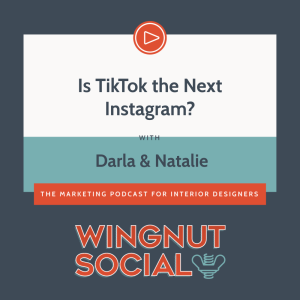
Monday Oct 07, 2019
Monday Oct 07, 2019
Just in case you haven’t heard—TikTok is the new app exploding onto the scene for kids and teeny-boppers worldwide. With over 500 million downloads, it’s projected to be the next “big thing” maybe someday passing the popularity of Facebook or Instagram. So what is this phenomenon we speak of?
TikTok is an app that allows you to record short 15-second videos whose content usually consists of a music video, comedy bit, or someone completing a challenge. So how does this remotely relate to the design space? Listen to this mini-poddy episode of Wingnut Social with Darla and Natalie to find out!
What You’ll Hear On This Episode of Wingnut Social
[1:10] Should designers be on Tik Tok?
[1:50] What is TikTok?
[5:00] Advertising on Tik Tok
[6:30] Do Hashtag challenges
[7:40] The Future of Tik Tok
Resources & People Mentioned
TikTok on GooglePlay
TikTok on App Store
ByteDance
GaryVee on TikTok
Lasso App
Vero
Snapchat
Join TikTok as an investment in your future
For those of you just mastering Instagram—watch out—there’s a new app that is going to explode in popularity. Not unlike Snapchat or the now non-existent Vine, TikTok allows you to connect with the world through video. It’s riveting and addicting and made oh-so-popular by Jimmy Fallon.
GaryVee even touts it as the “Training wheels for future influencers and content creators”.
So what should you do? Jump in the kiddie-wagon, now. Just like every other app geared towards a specific demographic, it eventually skews towards an, ahem, slightly-older less-trendy generation... Join Gen Z and build what audience you can, now. Then, when it morphs—as every other social media app does—it’s AI will have you up and running.
Create a hashtag challenge to build a following
Hashtag challenges are the big thing trending on TikTok. It can be anything from lip-syncing a song like a Disney princess to Jimmy Fallon’s #TumbleweedChallenge. So why not embrace the space and post a design challenge?
TikTok Recently integrated a “Hashtag Challenge Plus” feature that allows sponsors to create a hashtag challenge. Their featured hashtag has a shoppable tab that allows users to make purchases in-app. Kroger took advantage of this approach when they sponsored a ‘TransformUrDorm” challenge, asking users to post dorm-room makeovers featuring products purchased at Kroger.
Come up with a catchy hashtag and challenge tweens to design their room. There are budding designers who would be crazy about sharing their space and getting some air-time. Take this opportunity to get ahead of the curve and create a niche among the next generation.
Connect With Darla & Wingnut Social
www.WingnutSocial.com
On Facebook
On Twitter: @WingnutSocial
On Instagram: @WingnutSocial
Darla’s Interior Design Website
1-877-WINGNUT (connect with us for your social media marketing needs)
Subscribe to The Wingnut Social Podcast on iTunes, Google Podcasts, or TuneIn
Audio Production and Show notes byPODCAST FAST TRACKhttps://www.podcastfasttrack.com
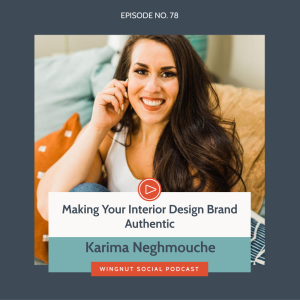
Wednesday Oct 02, 2019
Wednesday Oct 02, 2019
We hear a lot of talk these days about authenticity - it’s a buzzword that is quickly losing its meaning. But that doesn’t mean the concept is out of date, in fact, it’s more important than ever. So, when it comes to making your design brand authentic, what does it really mean?
On this episode of Wingnut Social, Darla and Natalie speak with Karima Neghmouche, a brand expert who works alongside all kinds of people - designers and otherwise - to help them discover, capture, and communicate a brand that is authentic to who they are. As a designer, that’s of paramount importance because the clients you attract will be attracted to your personal approach as much as they are attracted to your beautiful design work. Listen to hear all of Karima’s advice.
What You’ll Hear On This Episode of Wingnut Social
[5:20] Beyond the buzzword, what does “authenticity” mean?
[9:54] How simplified branding gives you the ability to pivot in the future
[13:36] Website principles for resonating with your ideal client
[16:50] Common mistakes designers make when building out a genuine brand
[20:40] Soul-searching processes to discover your authentic brand
[23:09] The importance of a great website
[28:39] Summary of the episode: focus on your closet!
Connect with Karima Neghmouche
Karima’s website - https://karimacreative.com/
On Facebook
On Instagram @Karima.Creative
On LinkedIn
On Pinterest
Resources & People Mentioned
The RESA Edge chat Darla will be doing
Darla’s upcoming presentation at High Point
BOOK: You Are A Badass At Making Money
Authenticity is keeping it real no matter what others say you should be doing
We all know authenticity is a buzzword, a trendy thing people tack onto their slogan or mantra. But behind the buzzword is a principle that is vital for designers to understand and apply. Here is Karima’s definition of authenticity:
Keeping it real and ignoring the noise of what everyone else says you should be doing.
That’s a pretty good definition. But there’s a trick to developing the relationship between branding and authenticity in today’s marketing. Filters and effects change how things are perceived, which is not how your brand may be best represented. Karima has a good perspective on what it takes to keep things authentic. It includes taking pictures of the favorite spaces in your own home. Listen to learn how it works out practically - and to understand why her approach is so helpful.
Practical ways to keep your interior design brand authentic
The authenticity of your interior design brand is what will appeal to your ideal clients - the ones you really want to work with. That’s because something about you and your personal perspective on design work draws them to you. So you want to make sure you’re getting this piece of the branding puzzle right.
Karima’s advice makes it so easy to see how everyday observations about your own life, the kind of things you are drawn to on Pinterest or Instagram, and the previous design work you’ve done will reveal some of the real you that needs to go into communicating an authentic interior design brand.
Don’t miss this episode. Karima digs into logos, websites, naming conventions, images used to represent your brand, and more. She’s also going to share why simplicity in your branding is often a better path than specificity.
Connect With Darla & Wingnut Social
www.WingnutSocial.com
On Facebook
On Twitter: @WingnutSocial
On Instagram: @WingnutSocial
Darla’s Interior Design Website
1-877-WINGNUT (connect with us for your social media marketing needs)
Subscribe to The Wingnut Social Podcast on iTunes, Google Podcasts, or TuneIn
Audio Production and Show notes byPODCAST FAST TRACKhttps://www.podcastfasttrack.com

Monday Sep 30, 2019
Monday Sep 30, 2019
As Darla and Natalie have pointed out a few times in the past few months, the ease with which you used to be able to build a following on Instagram has waned. Big time! You’ve got to do some super special stuff to get your posts seen so that you can build a significant following.
What kind of super special stuff is it that you have to do? The good news is that it’s simple stuff. The bad news is that it’s a lot of work. Nobody said this social media marketing thing would be easy. Join Darla and Natalie for this mini-poddy episode of Wingnut Social as they discuss how to get on the Instagram explore page!
What You’ll Hear On This Episode of Wingnut Social
[1:53] The current difficulty of Instagram can be overcome by this hack
[2:59] What IS the Instagram Explore page?
[6:20] Practical tips to make it happen!
Resources & People Mentioned
Instagram explore page
Ripple App
Hootsuite
Sprout
Later app
TechCrunch article about Instagram explorer page
Life Lapse app (stop motion)
Enlight Pixa Loop
In-shot video editor
Over video app
Boomerang app
Adobe Photoshop (to do gifs)
What the HECK is the Instagram explore page?
If you’re a frequent user of Instagram you’ll be familiar with the little search icon - it looks like a magnifying glass. That’s the doorway to the Instagram explore page. Once you click on it you’re going to see a lot of content that’s been specially curated for you.
The magical algorithms of Instagram choose posts for your explore page uniquely, based on things you’ve liked, pages you’ve followed, the stuff those pages like and share, and more. It’s like a robot looking over your shoulder to keep track of everything you and the pages you like pay attention to on Instagram with one purpose: to serve you up more of the same.
Why is it important for you to get your posts on the Explore page? Because 200 million people visit the explore page every day. That’s a lot of people - and a lot of eyeballs (400 million, give or take a few). And keep in mind, every user's experience with the explore page will be curated for them - so if you’re showing up there, it means that somewhere along the line they have expressed some kind of interest in the type of things you post. That’s a potential following waiting to be found! Listen to learn how to get on the Instagram explore page!
9 tips to get your content on the Instagram explore page
You might notice that this mini-poddy episode is a bit longer than our normal minisodes. Why? Because Darla and Natalie go into the details of the following 9 hacks you can use to get your posts on the Instagram discover page. You won’t want to miss these…
Create a post that is good! (tips in this episode)
Video does well on the explore page (tips for making them great in the episode)
Post at smart times of day
Your posts need to get engagement quickly
Include a call to action (best practices shared)
Discover and use the best hashtags (how to find and use niche hashtags)
Learn from and copy what the influencers in your niche are doing that is successful
Stories can be leveraged for the Instagram discover page as well (tips on this episode)
Stylized quotes seem to do well (Mel Robbins is killing it with this strategy)
Interested in getting on the Instagram discover page with your content? Listen to hear how to do it.
Connect With Darla & Wingnut Social
www.WingnutSocial.com
On Facebook
On Twitter: @WingnutSocial
On Instagram: @WingnutSocial
Darla’s Interior Design Website
1-877-WINGNUT (connect with us for your social media marketing needs)
Subscribe to The Wingnut Social Podcast on iTunes, Google Podcasts, or TuneIn
Audio Production and Show notes byPODCAST FAST TRACKhttps://www.podcastfasttrack.com
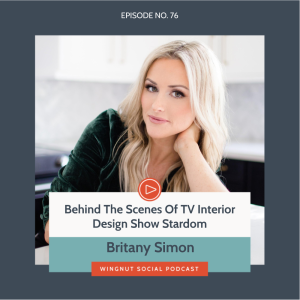
Wednesday Sep 25, 2019
Wednesday Sep 25, 2019
We’ve all seen and been enthralled with what happens on those TV Interior Design shows. There are so many great ones to choose from. And if we will be honest, every one of us who works in the design world has wondered what it would be like to star on one of those shows. Well, fellow wingnuts, wonder no more!
This episode is a delightful conversation with Britany Simon - star of several TV Interior Design shows. Darla and Natalie talk with her about the behind the scenes world of those productions to find out whether it’s as glamorous as it seems and what benefits come to a designer who gets that kind of limelight. Britany also gives her best advice for anyone who wants to pursue the same types of opportunities.
In her characteristic way, Britany gives us the unvarnished truth. Be sure you listen!
What You’ll Hear On This Episode of Wingnut Social
[1:20] The new Tequila diet isn’t really working in spite of internet promises
[2:30] Brittany Simon’s rise into the media limelight
[5:30] The circumstances that led Brittany to television
[10:04] The story behind TV design - how it really works
[16:38] Why Britany first decided to try out for a TV design show
[19:00] The opportunities that have come from being on TV as a designer
[21:01] Britany’s advice for those interested in getting on a TV design show
[22:59] The marketing that Britany does for her shows and brand
[27:23] Britany’s learning curve for becoming comfortable on camera
[29:24] The What Up Wingut round
Connect with Britany Simon
Britany Simon’s website
Britany on Pinterest
Britany on Instagram: @BritanySimon
Britany on Facebook
Resources & People Mentioned
Best Room Wins Show
The Design Star Show
Hotel Impossible TV show
Joanna Gaines
Abbi McCollum on Wingnut Social
FYI channel
Bravo channel
HGTV channel
The Foundress (women in business group)
BOOK: The DNA Of Relationships
So you want to star on an Interior Design TV show, do you?
Britany first put her name in to be considered for “The Design Star,” a show from HGTV. She didn’t know if she had a chance of making the cut because she’d never done any work on camera or in front of an audience, but she figured it was worth a try. She and her husband drove to Las Vegas so she could audition for the show and the rest is history. But what she discovered behind the scenes was a world of extremely hard work. She jokingly says she often ended her production days in the fetal position.
The kind of things she had to deal with were unexpected. For example, she was assigned a design assistant who was not at all ready for the kind of work involved and who didn’t know how to go about sourcing the items she would need. So Britany had to take that on herself. She also had to work tirelessly on the things the show’s producers assigned to her to meet the deadlines for the show - including a number of DIY projects. Listen to hear how the perceived glamor of being on the show turned out to be not so glamorous.
What is the return on staring on your own design TV show?
One of the things Darla was interested in finding out was how Britany’s many TV shows have benefitted her design business. After all, Joanna Gaines seems to have done pretty well from her TV opportunities.
What comes to light in this conversation is that Britany is a designer at heart and always wants to have her hands in the actual process, so to grow her business rapidly and in a way that puts her in more of a management role was not attractive to her - at all.
So thankfully, that’s not what happened. While it’s true that Britany has had many and varied offers as a result of her television stardom, she’s been able to remain in her sweet spot of designing. She's been the choice of many clients simply because they saw her work on TV and took it upon themselves to track her down so they could have her design their homes. That’s the kind of exposure money can’t buy and Britany has made the most of it.
We hope you’ll listen to this episode to get to know Britany. She’s down to earth, transparent, and a joy to talk with. You’ll find yourself feeling happy that she’s been the one to experience the kind of success she has - even if you secretly envy her - like we do.
Connect With Darla & Wingnut Social
www.WingnutSocial.com
On Facebook
On Twitter: @WingnutSocial
On Instagram: @WingnutSocial
Darla’s Interior Design Website
1-877-WINGNUT (connect with us for your social media marketing needs)
Subscribe to The Wingnut Social Podcast on iTunes, Google Podcasts, or TuneIn
Audio Production and Show notes byPODCAST FAST TRACKhttps://www.podcastfasttrack.com
Clean and compress CSS files for an optimized website. Try the free online tool by HTML Cleaner.

Monday Sep 23, 2019
Monday Sep 23, 2019
Instagram statistics can be pretty boring to wade through - so never fear, we’ve waded through them for you! In this mini-poddy, we’re bringing the most valuable takeaways of a recent Instagram study to your earbuds, so you can make better decisions about the way you use Instagram to highlight your brand.
You’re going to learn about video, carousel image groups, optimal caption length, and get our take on the infamous Instagram hashtag debate. Listen, learn, and apply what makes sense to you - and make Instagram a powerful traffic driver to your design business.
What You’ll Hear On This Episode of Wingnut Social
[1:50] Where we found some interesting Instagram Statistics
[4:01] Do you know what outperforms static images on Instagram?
[5:06] Does caption length matter?
[8:31] Should you use hashtags inside your Instagram posts?
Resources & People Mentioned
www.Info.Quintley.com/Instagram/Study/2019 - Instagram stats you may find interesting
Our High Point Market Minisode
The Highpoint Market Pre-Tour (from Linda Holt)
Darla’s upcoming presentation at High Point
Instagram statistic of interest #1: Images are great. Video is better
For a few years now the social media gurus have been telling us that video performs better than static images. It's true because video provides the benefit of communicating your personality and “vibe” a lot better than images. Having said that, here’s the weird thing: 48% of brands are only using static images, not video. What?!!!!
If you are not using video on Instagram, these stats show that you’re missing the boat. Video gets 48% more engagement from followers than static images alone. That means you have more opportunities to interact with potential design clients simply by using video regularly. Listen to learn more.
Instagram stat of interest #2: The sweet spot for captions
When you scroll through Instagram, you’ll see that some images and videos have accompanying captions, others don’t. You know what captions are, right? They are those descriptions or comments that go along with the images or videos you post. Some Instagram users who make use of captions write books in the captions (we don’t have time to read books on Instagram). Other’s keep them short and sweet.
The Instagram statistics revealed in the recent Quintly study say that the sweet spot for captions is not so much about how long they are, but what you do with the first 125 characters. 125 is the magic number because once you write more than 125 characters, Instagram truncates the caption and users have to tap the “read more” ellipsis thingie. So if you’re going to use captions, make the most of that first 125 characters. Hook your followers with that text. Make your copy so good they can’t HELP but tap for more.
Go ahead and hit the play button on this episode. We also talk about how 10 or more emojis could help your Instagram efforts be more effective, and give you our opinion about the infamous hashtag debate (in the post, or in the comments?) - based on the Instagram statistics we discuss on this episode.
Connect With Darla & Wingnut Social
www.WingnutSocial.com
On Facebook
On Twitter: @WingnutSocial
On Instagram: @WingnutSocial
Darla’s Interior Design Website
1-877-WINGNUT (connect with us for your social media marketing needs)
Subscribe to The Wingnut Social Podcast on iTunes, Google Podcasts, or TuneIn
Audio Production and Show notes byPODCAST FAST TRACKhttps://www.podcastfasttrack.com
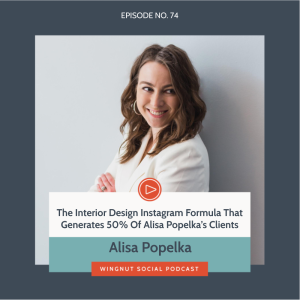
Wednesday Sep 18, 2019
Wednesday Sep 18, 2019
A while back Darla noticed this gal - Alisa Popelka - EVERYWHERE on social media. She was especially rocking Instagram. It was like she had the Interior Design Instagram formula for success. And it turns out that wasn’t far from the truth.
As the two got to know each other via social media they struck up an online friendship. That's when Alisa decided to crank up her Instagram strategy even more by signing up for the Wingnut Social strategy package. The results of adding what she learned to what she was already doing have been astounding. Alisa says that 50% of her existing clients first contacted her through Instagram. FIFTY PERCENT! What would it do for your business to KNOW that you can generate more clients using ONE platform?
But it's not only about clients. Alisa has learned to use Instagram to get the attention of strategic partners in her area and those in her industry who she believes will be an asset to her business. Don’t miss this episode. It’s short, but it’s super sweet. Alisa’s advice is GOLD.
What You’ll Hear On This Episode of Wingnut Social
[1:22] Response to our Highpoint Market Minisode - and an additional tip
[3:06] A personal story about Alisa Popelka, the ubiquitous designer
[5:57] The social media marketing focus of Alisa’s interior design biz
[7:16] Sharing the work of other designers to increase your own reach
[9:57] How the social media light bulb went on for Alisa
[10:55] 50% of her clients come from Instagram: Here’s how it happens
[14:32] The consistency rule: Why you have to stick with it
[17:48] How much time does Alisa put into Instagram each week? A lot
[20:23] Social media strategy tips Alisa learned from her Wingnut coaching
[25:36] Alisa’s #1 piece of advice for designers not investing in social media: do the work
[26:38] The What Up Wingnut Round
Connect with Alisa Popelka
Alisa’s website: https://www.alisacristineinteriors.com/
Alisa on Instagram: @AlisaCristineInteriors
Alisa’s work on Facebook
And Alisa on Pinterest
Resources & People Mentioned
Our High Point Market Minisode
The Highpoint Market Pre-Tour (from Linda Holt)
Darla’s upcoming presentation at High Point
Instagram
Planoly app - an Instagram curation app
BOOK: Start With Why by Simon Senek
The RESA Edge chat Darla will be doing
50% of Alisa’s clients come from Instagram. Seriously
There are many Interior Designers who don’t believe that social media can do much for their business. It’s a hassle, it takes too much time out of the day, and it’s more about vanity and showing off than it is truly connecting with legitimate clients. That’s what THEY say. But Alisa Popelka would say something FAR different.
Alisa has been doubling-down on her Instagram strategy for some time now, and she’s got carefully documented stats to show that at least 50% of her current clients have come to her directly from Instagram. As a result, she’s a very busy designer. She’s convinced that it’s more than worth the effort to make Instagram the primary way of marketing her business. She even refers to Instagram as a “free marketing tool” every designer should be using. Listen to learn more of her secret sauce.
Being intentional is vital to an effective interior design Instagram strategy
If there’s one secret to Alisa’s success using Instagram to generate more client leads, it’s this. Be intentional and consistent. OK, that’s two things - but they are both important.
Lisa doesn’t do anything on Instagram in a haphazard way. She spends two days every month to plan out her content, including the captions that will go with and on her photos. She uses a curation app to schedule it all out at regular intervals. She determines what other designers and local events she will share. And she budgets time into every day to engage with the comments and activity surrounding her posts and the posts of those she follows.
If that sounds like a lot of work to you, you’re right. But it’s the kind of work required to put your design work into the orbit of the exact people you want to work with. If you’re willing to take an intentional, disciplined approach like Alisa has, you’re going to win at Instagram. No question.
Listen to this episode to hear every detail Alisa shares about her Interior Design Instagram strategy!
Connect With Darla & Wingnut Social
www.WingnutSocial.com
On Facebook
On Twitter: @WingnutSocial
On Instagram: @WingnutSocial
Darla’s Interior Design Website
1-877-WINGNUT (connect with us for your social media marketing needs)
Subscribe to The Wingnut Social Podcast on iTunes, Google Podcasts, or TuneIn
Audio Production and Show notes byPODCAST FAST TRACKhttps://www.podcastfasttrack.com
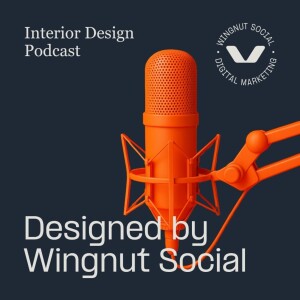
Monday Sep 16, 2019
Monday Sep 16, 2019
You may not have grabbed a copy of Pat Flynn’s new book, “Superfans” yet - Darla has it but hasn’t made space in her busy schedule to read it yet - but you need to understand the term all the same.
A superfan is exactly what it sounds like - a person who truly loves the things you do, whatever that might be. They comment on your social media posts. They share your stuff with others, they even reach out to you directly from time to time via DM or email or whatever.
This episode is about handling superfans the right way because when you do, they provide something you can’t buy.
What You’ll Hear On This Episode of Wingnut Social
[0:55] What are superfans and why do you need them?
[4:30] The simple (but not easy) way of attracting superfans
[7:50] A simple example of a missed opportunity to create superfans
[8:59] One of the best social media superfan builders out there (MoonPie)
[11:30] Pay attention to the details of your engagement with people
Resources & People Mentioned
Pat Flynn’s book “Superfans”
The Ivy Design Group
MoonPie’s Twitter account
BOOK; Jab, Jab, Jab, Right Hook
Brittanie Elms episode on Wingnut Social
Simply taking the time to respond to people could create superfans
We’ve all been there - charging through a busy day and spinning all the plates when a random email from a random person pops up in our email inbox. It’s long. Really long. And the message raves about your last blog post or social media image or latest design portfolio. It might even ask very specific questions you don’t feel you have time to answer.
Don’t ghost that person. Don’t hit “delete.” You need to respond to them - not necessarily right at that moment, but you have GOT to get back to it soon. Why? Because that person is telling you that they are a superfan of your work. That means their influence on your behalf could be HUGE.
Listen to learn how to make the most out of interactions with superfans once you hit the “reply” button on that email.
Superfans are born from treating people like they deserve to be treated
Yes, a good relationship with a superfan could benefit you and your business. But that’s the secondary issue. Uppermost in importance is that those people used their precious time to correspond with you, and they are people worth caring about.
They are not a bother, or irritation, or inconvenience. They are human beings who deserve your attention and care. How you respond to them is a reflection of your character, which is the thing they care about most, even more than the great work you do.
In this episode, Darla and Natalie give a handful of examples of the quality relationships they have been able to build with superfans in just the past few years, and how those relationships in and of themselves have become very satisfying - even if they never lead that person to do business with them at all. Listen to hear how the superfan thing works - and how you can make the most of it relationally and for your design business.
Connect With Darla & Wingnut Social
www.WingnutSocial.com
On Facebook
On Twitter: @WingnutSocial
On Instagram: @WingnutSocial
Darla’s Interior Design Website
1-877-WINGNUT (connect with us for your social media marketing needs)
Subscribe to The Wingnut Social Podcast on iTunes, Google Podcasts, or TuneIn
Audio Production and Show notes byPODCAST FAST TRACKhttps://www.podcastfasttrack.com

Wednesday Sep 11, 2019
Wednesday Sep 11, 2019
As you’ll hear during the first part of this episode, just the thought of hiring an interior design virtual assistant stripped Darla’s gears a bit. That’s because there’s so much specialization, so many moving parts, and a ton of location-dependent stuff involved in design work. She couldn’t see how an assistant who’s not on location could be effective.
But now she’s seen the light - thanks to Brittanie Elms.
On this episode of Wingnut Social, you’re going to hear how Brittanie became an interior design VA, how she has learned about the design industry enough to provide tremendous value to designers of all stripes, and how her service turns into a cost savings instead of an expense for most designers.
It’s an amazing concept - and one our team is likely to take advantage of very, very soon. Don’t miss this incredibly practical episode.
What You’ll Hear On This Episode of Wingnut Social
[1:15] Impressive results from Darla’s Tequila diet (to get ready for Highpoint)
[2:28] Darla’s speaking at The RESA Edge and Highpoint Market
[7:39] Brittanie Elms: The decision to start a virtual design assistant company
[13:02] How is it even possible to work with an interior design virtual assistant
[19:58] The benefits of hiring a virtual assistant for interior design
[23:20] How robust can this really be for interior designers?
[26:43] Can a design virtual assistant service truly keep up on design trends?
[34:47] Brittanie’s best advice to designers looking for a virtual assistant
[37:22] The channels Brittanie uses to market her services to designers
[38:40] The Whatup Wingnut round
[44:14] Should we do it? Would the leap be worth it?
Connect with Brittanie Elms
www.MyDesignAssistant.com - Brittanie’s company
Brittanie on Twitter: @mydesignassist
Brittanie on Facebook
Brittanie on Instagram: @MyDesignAssistantBusiness
The MDA Collective (Brittanie’s Facebook Group)
Resources & People Mentioned
The RESA Edge chat Darla will be doing
Highpoint Market
A Well Designed Business Podcast
Trading Spaces
The Kelly Fridline episode on Wingnut Social
My Doma Studio
Designer Inc
Pinterest
BOOK: The Boy Who Was Raised As A Dog
A design VA is for when you need to keep your sanity, but you don’t have the cash to hire full time
We have plenty of people working full time as a part of Wingnut Social and as part of the Darla Powell Interior Designs team. It’s great to have a staff that can run with projects and get things done. But sometimes you have small little things to be done that don’t justify another full-time hire. And you don’t want to add to the already-full schedule of some poor soul on your team, either. What do you do?
Hire a VA to take on that task. Not only is it cost-effective it’s also a way to tap into the brilliance and giftedness of someone who is an expert at exactly what you need to be done.
As you listen to this conversation you’ll hear Brittanie explain how various Interior Design Virtual Assistant roles might look, and how each of them could benefit your design practice. She’s already got Darla thinking about things unrelated to design but that are integral to our business - like email and other correspondence. Listen up! There’s good stuff here for you.
How does hiring an interior design virtual assistant impact the bottom line?
Naturally, when you have a task or two that don’t fit into the job description of one of your full-time staff people, a VA makes sense. But how do you ensure that the cost you incur in bringing on a VA is worth it?
The answer is this: You need to be VERY intentional about the work you pass to a VA.
Give them the things that drain you, that you don’t like to do, that slow down your creative process and drag out design jobs. That way you will be freed up to do your best work and deliver for your design clients in a bigger way.
And consider this too - you may need more than one VA. One person is not likely to be skilled at every one of those small things you need to offload, so don’t expect them to be. Bring in multiple people who operate in different zones of genius so that you have a team of specialists rather than one or two generalists. The difference could be huge.
And finally, there’s the practical part of it all. When hiring a VA you’re hiring a contractor. That means you don’t have to pay for unemployment insurance, contribute to taxes or social security, or any of the other hoopla the government requires for full-time employees. That alone could be enough cost savings to pay for the VAs fees in the first place.
Listen to this episode to get all the details about working with an Interior Design Virtual Assistant - and if you want to reach out to Brittanie you’d better do so quickly. We have a feeling her schedule is about to fill up with new clients.
Connect With Darla & Wingnut Social
www.WingnutSocial.com
On Facebook
On Twitter: @WingnutSocial
On Instagram: @WingnutSocial
Darla’s Interior Design Website
1-877-WINGNUT (connect with us for your social media marketing needs)
Subscribe to The Wingnut Social Podcast on iTunes, Google Podcasts, or TuneIn
Audio Production and Show notes byPODCAST FAST TRACKhttps://www.podcastfasttrack.com

Monday Sep 09, 2019
Monday Sep 09, 2019
Turn your prospects into super fans with Bonjoro
When it comes to making a real and personal connection with clients, video connections beat email, text, or instant messenger, hands-down. And the impact it can have is powerful.
But creating a personalized video is tough, from a time and technology standpoint. Until now. On this mini-poddy episode Darla introduces you to a fun new app she’s using called Bonjoro. You’re going to love this!
What You’ll Hear On This Episode of Wingnut Social
[1:10] A cool new app: Bonjour-O - to make personalized videos
[4:49] Using this as a designer or to serve clients in a personal way
[7:46] Examples of how Darla has used it so far
[9:12] We are speaking again: October 19th, 4PM - at Creative Touch Rugs
Resources & People Mentioned
The Bonjoro app
What if you could send every new client a personalized video?
What would happen in your head if you signed up for a newsletter or free PDF download and instead of the usual blah-blah-blah email, you got a video - and the person making the video connection used your name as they spoke to you personally, by name. You’d wonder, “How did they do that?!!” Then you’d hang on every word they said.
That’s what YOU can make your clients or prospects feel by using this cool new app - Bonjoro. Darla’s been trying it out and has discovered that it’s pretty easy, quite simple to use, and that the tech part actually works! Listen to find out more.
Darla’s already making video connections -and she’d love to receive one from you
As Darla mentions on this episode, she’s already used the Bonjoro app to send videos to a few Wingnut Social prospects, has connected with existing clients using the app, and has even used it to reach out to a few of her interior design leads. It’s too early to tell exactly how impacting it’s going to be, but the cool way it makes HER feel to get a Bonjoro message gives her reason to believe her clients will feel the same way.
And she’d like to invite you to give it a try. There’s a free version of the app and a full-featured free trial so you can test it out. If you do, send Darla a Bonjoro video. She’d love to hear from you and be inspired by seeing how you are using the app.
Connect With Darla & Wingnut Social
www.WingnutSocial.com
On Facebook
On Twitter: @WingnutSocial
On Instagram: @WingnutSocial
Darla’s Interior Design Website
Subscribe to The Wingnut Social Podcast on iTunes, Google Podcasts, or TuneIn
Audio Production and Show notes byPODCAST FAST TRACKhttps://www.podcastfasttrack.com
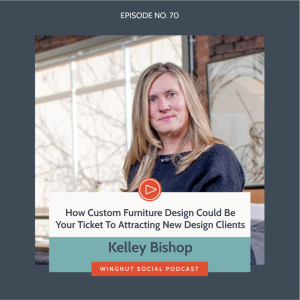
Wednesday Sep 04, 2019
Wednesday Sep 04, 2019
Many times, design projects need something special, something unique to set off the entire vibe of what you’re doing in a room. Enter custom furniture design.
Yes, it sounds intimidating and like it might require skills you don’t have, but there are ways around that. Darla and Natalie’s guest on this episode is going to explain how you can pull it off.
Kelley Bishop is the owner and designer behind Steel and Plank furnishings, a custom design furniture company that she started as a second business while she was still working as an architect (she’s still partner in an architectural firm even now, BTW). Kelley has developed a custom fabrication shop that enables her to create both entire structures or custom pieces that delight her clients.
Join the conversation to hear how Kelley made the transition from architect to custom furniture designer, how she’s getting her custom wares out into the world, and how she suggests you think about offering custom-designed furniture to your clients and developing the partnerships that will enable you to do it.
What You’ll Hear On This Episode of Wingnut Social
[1:51] Darla’s upcoming speaking gigs you don’t want to miss
[5:02] What you’re going to hear from Kelley Bishop on this episode
[7:10] The frustration that moved Kelley from being an architect to a furniture designer
[14:10] How can designers get started creating custom pieces for client homes?
[17:34] The best ways to offer custom furniture design to clients
[21:50] Is it possible to design furniture that could lead to licensing agreements?
[26:32] Kelley’s newest ventures: curating and manufacturing her own lines
[30:13] The “What Up Wingnut” round
Connect with Kelley Bishop
Steel and Plank - Kelley’s business
Kelley’s Instagram: @SteelAndPlank
Steel and Plank on Pinterest
Steel and Plank on Facebook
Resources & People Mentioned
Darla is speaking at Highpoint Market with Nicole Heymer
She’s also speaking at the RESA Edge chapter - https://ResaEdgeBroward.4stagers.com
The Design Influencers Conference
Wingnut Social episode with Nicole White
Auburn University’s Rural Studio
Widell and Boschetti
Furniture Branding
BOOK: Zen and the Art of Motorcycle Maintenance
From architect to custom furniture designer? How did THAT happen?
In this episode, Kelley shares how she got into designing custom furniture - and the story goes way back to her childhood. Her father both modeled and encouraged her to figure things out so that she could do them herself. He was always fixing or building things on his own instead of hiring someone to do it for him. Kelley learned the lesson so well that she partnered with her Dad to rebuild an MG motorcar as a teen. Fast forward from there and apply that attitude to the design of furniture, and you’ll see how her creative, industrious bent could create some amazing pieces.
If you take the time to listen to this episode, you’ll see how Kelley's “figure it out” attitude has lead to an entirely new and profitable business that she absolutely loves, and how Steel and Plank has become a showcase for her work and the work of others who offer complementary wares. It’s a great story you’ll want to hear..
Why would you want to suggest custom furniture as a designer?
As designers, most of us are busy enough with all the moving parts of the typical design project. But we have to admit that we come across situations when something else is needed for a project, something special to bring things into focus and alignment. Could that “something” be a special piece of furniture that is truly one-of-a-kind?
Naturally, not every client is going to be interested in custom furniture pieces as part of the design package you put together for them. But some will be - and “custom” means “cha-ching” for your bank account. The beautiful part is this: Clients who are interested in custom pieces typically know that fact - and are willing to pay the extra money to have something unique in their homes.
What’s the best way to talk about custom furniture design with clients?
If you’re going to offer custom furniture design, you’ll need to be able to describe it in a way that is appealing to clients and that explains the process that will take them from concept to construction to placement in their home. It may sound simple but it’s not. Many things can easily go sideways along that path.
Darla was curious about how to approach the messaging regarding custom furniture options so she asked Kelley to share her best advice for designers who want to start offering custom furniture to clients. Kelley says it’s a process of knowing the client’s desires, exploring those effectively, and having the right relationships and resources to pull it off. You’ll have to listen to get all the details.
Clients need to connect with the furniture you create as much as they need to love that it is custom
We easily understand how a client would feel to have a true one-of-a-kind piece in their newly designed home. Excited - unique - special. But much of the time, “special” is not enough. People want to have a deeper connection to the pieces they select - and it’s your job as their designer to help them make that connection.
How? You do it by learning the story behind the piece - and you do that by developing a great working relationship with the furniture designer. Kelley believes this is one of the most important aspects of selling custom furniture design to clients. You want to connect them to the furniture, not just its uniqueness. This lady has a wealth of insight to share and provides many details that will benefit you, so be sure you listen.
Connect With Darla & Wingnut Social
www.WingnutSocial.com
On Facebook
On Twitter: @WingnutSocial
On Instagram: @WingnutSocial
Darla’s Interior Design Website
Get the Wingnut Social custom services package: www.WingnutSocial.com/services or call 1-877-Wingnut
Subscribe to The Wingnut Social Podcast on iTunes, Google Podcasts, or TuneIn
Audio Production and Show notes byPODCAST FAST TRACKhttps://www.podcastfasttrack.com
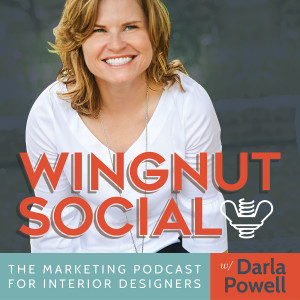
Monday Sep 02, 2019
Monday Sep 02, 2019
Tailwind is an incredibly helpful app that enables auto posting and more for Pinterest.
Yes, Pinterest - we’ve been a bit neglectful of the platform for a while but since Instagram appears to be in kind of a lateral stall lately, Darla decided to jump back on to see what it might have to offer.
Boy! There is a lot that’s happened with Pinterest in our absence! Take a few moments to listen, learn about Tailwind, Tribes, and Pinterest - and find out how you can join our new little Design Tribe on Tailwind to help you get your Pinterest shares rocking!
What You’ll Hear On This Episode of Wingnut Social
[0:50] The Pinterest Design Bloggers United Tribe - wanna join us?
09:01] What is Tailwind?
[6:11] The amazing benefits Pinterest Tribes made with just a few tweaks
Resources & People Mentioned
Tailwind (look for Tribe - Design Bloggers United)
Melissa’s episode about Pinterest (episode 16)
Join our Tribe!
Design Bloggers United
Hurricane Dorian missed us - but we’re catching the Tailwind (see what we did there?)
When Darla jumped onto Tailwind to see what was going on with the app she discovered something amazing. You can now become part of a “tribe” - or make your own! What is a tribe? It’s a group of people who share pins oriented around the same topics - like design work. Those people rally together to share each other’s pins and give everyone involved a boost in the Pinterest algorithms in the process.
Dara’s created her own tribe - Design Bloggers United - and is inviting you to be a part of the tribe. Just grab the Tailwind app, find the Design Bloggers United tribe, ask to join, and once you’re approved you’ll be able to get in on all the Pinteresting fun (see what we did there, too?).
Why Pinterest? Why now?
This little PInterest experiment comes about because of an encounter Darla had with a new Wingnut Social client. As she shared her social media status, Darla noticed something - there were plenty of social platforms our team could definitely help her with, but she was rocking Pinterest in amazing ways all on her own. A little bit of prodding later, and Darla found out it was Tailwind Tribes at the heart of the action. Nothing like a little bit of humble pie to give you a new obsession, huh?
Connect With Darla & Wingnut Social
www.WingnutSocial.com
On Facebook
On Twitter: @WingnutSocial
On Instagram: @WingnutSocial
Darla’s Interior Design Website
Subscribe to The Wingnut Social Podcast on iTunes, Google Podcasts, or TuneIn
Audio Production and Show notes byPODCAST FAST TRACKhttps://www.podcastfasttrack.com



